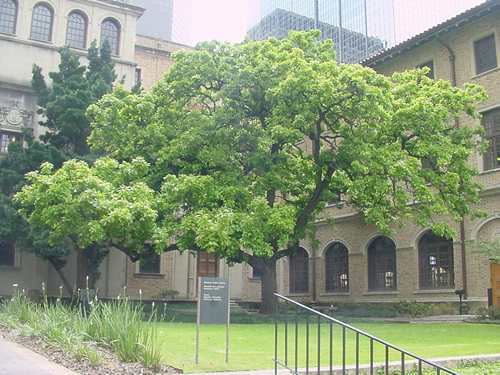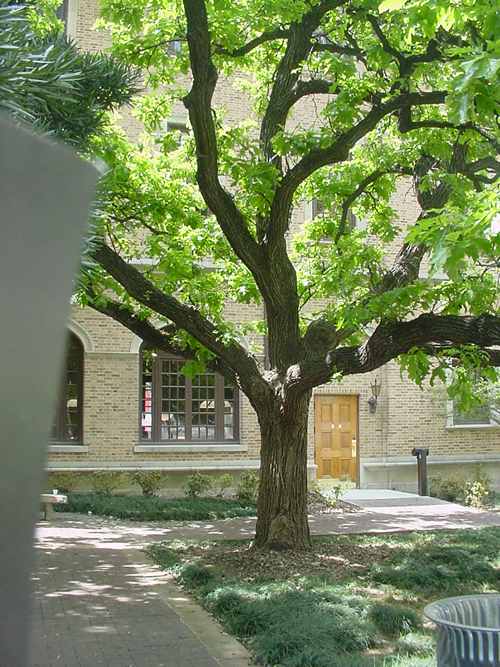|
|
Texas
| Features | Ghosts
Houston's Basement-dwelling,
Tree-planting, Violin-playing, Dog-loving,
Butter-making Ghost
There's nothing
to not like about the Ideson Library or "Cra"
the building's civilized resident spirit.
Houston,
Texas
by Johnny Stucco |
Houston's
Ideson Library McKinney Street Entrance
Photo by John
Troesser, 2007 |
How
many Texas ghosts provide their own death certificate? Not many. Considering
the space that he "haunts" it's altogether fitting that there should
be some documentation. But if you're looking for a complete
write-up, a photo I.D. or his mother's maiden name, forget it. No
self-respecting spirit would be caught dead with a complete resume.
Ghosts generally like to keep (at least) at arm's length and the spirit
of Julius Frank Cramer is no exception to this rule. His complete
name is known as well as the date and cause of his nonviolent death
(pulmonary hemorrhage aggravated by chronic prostatic problems). Also
known is his place of birth (Baltimore, Maryland) and where his body
was buried (Hiawatha, Kansas). But a story wrapped up with a bow,
it is not.
The Ideson Library has a file on the late Mr. Cramer which they will
provide, providing the requestee isn't too breathless or wide-eyed.
Someone has taken the time to look him up in the old city directories
and have put his various employment and residences down on a single
sheet. There aren't that many. His first entry was as an employee
of the Star Creamery where his job was listed as a butter-maker. His
address was the same as the creamery - the first of what was to become
a trend in Mr. Cramer's life. He also worked for the Milam Seafood
Company and his address was the same as that company. He had also
been custodian of Houston's old (first) Carnegie Library building
which was replaced by the building now known as the Julia Ideson Building.
When he became security guard/ gardener/ custodian/ janitor (and you
thought a custodian and a janitor were the same thing) of this building,
his address was given as the library's side street entrance.
If Julius had a love interest, it is not known. The music which he
allegedly plays are uplifting Strauss waltzes, not moody romantic
pieces.
Julius' mysteries are both large and small. On the death certificate
box reserved for type of death the word "Sudden" appears - followed
by a question mark. That's the coroner's mild afterthought since he
wasn't curious enough to perform a complete autopsy. Cra's remains
were then shipped to a sister who lived in the NE Kansas town of Hiawatha.
|
Canine and
Human Race
Sheet music occasional found scattered around the library seem to
be the only tangible manifestation of Cra's presence. Other than the
music, the only other acoustic clues are the sounds of his dog's nails
clicking on the building's marble floors and staircases. All stories
in the files agree that Cra's dog was a German Shepherd, even though
there's a discrepancies over Mr. Cramer's race. Several stories have
him listed as a Black man who attended church in nearby Freedman's
Town, while others mention him as "white." |
Whom Do You
Trust?
Other discrepancies include his age which is given as either 43 years,
2 months and 3 days (as published in the November 24, 1936 copy of
the Houston Post) or 79 years, 8 months and 16 days on the copy of
the death certificate. |
 |
The Bagby
Oak and "The Cramer Oak"
The best story of Julius Cramer may not his presence in the building,
his musical talent or even his spirit dog. It's a very real presence
that you can touch (and even climb on early Sunday mornings). And
best of all, it can be visited 24/ 7 for it isn't confined by library
hours. It's one of the two oak trees that grow on the building's north
side.
The trees (deciduous Red Oaks and not the Live Oaks one would expect
in Houston) are immediately noticeable for their difference in size.
The largest is thought to have been planted by the Bagby Family (original
land owners of the library site) in 1854. This tree, which was once
in danger of being cut by a proposed architectural change in the library,
is the parent of the smaller tree. It is said that in his role of
gardener, Julius took a seedling from the Bagby Oak and moved it to
its present location where he insured it got an arboreal head start.
|
 |
That's about
all that was contained in the file of J. F. Cramer, although there
is undoubtedly a photo of him somewhere in the library. Perhaps in
a fading staff photo. Someone who had researched the story prior to
our arrival had placed a single leaf from Julius' tree in the folder.
A thoughtful act - considering that there's no guarantee that the
tree will be here as long as Mr. Cramer's spirit.
© John
Troesser
October 25, 2018 Column |
|
|
